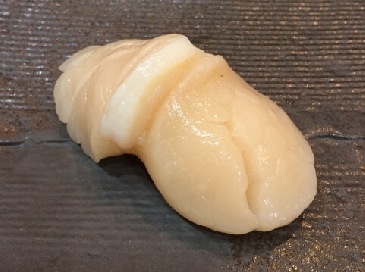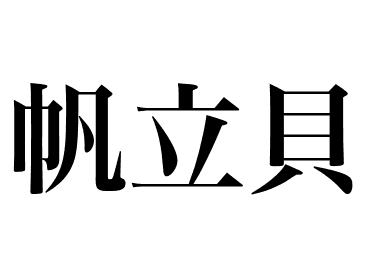Shellfish


Common scallop (Hotate)
【Nigiri sushi: Kai】
What is Hotate?
Hotate is a Japanese word that means scallop. Hotate lives in the sandy floors of shallow sea waters and prefers regions with water temperature from 5 to 19℃, which means they are found from the Sanriku coast northward. The Sanriku coast is located in Japan’s Tohoku region. There are especially high concentrations along the Hokkaido and Aomori coastlines. For a long time, Japan boasted the highest production of scallops in the world, but China started scallop farming in the 1980s. China’s production has surpassed Japan’s and is now the highest in the world, but they are producing Azumanishiki and Atlantic bay scallops, which are different species and a size smaller than Japanese scallops.
Hotate (Scallops) is rich in protein, fat, calcium, vitamins, iron, phosphorus, etc. The main component of the adductor muscle is protein, and it has the highest protein content of any Japanese shellfish. It doesn’t have a strong kick and has a flavor that everyone loves that comes from glutamic acid (an amino acid), glycine, alanine, arginine, etc. The adductor muscle also has a high content of glycogen from Spring to Summer, so its umami increases. It also contains taurine, which facilitates eye and brain development and reduces cholesterol.
What does Hotate (Common scallop) nigiri sushi taste like?
The adductor muscles of scallops are used as sushi ingredients. They are broadly characterized as ear-stringed cultured scallops from Funka Bay and Mutsu Bay, and natural scallops from the Okhotsk coast. The natural scallops caught in the cold northern sea have a strong sweetness and tender flesh. In summer its flesh becomes even thicker and sweeter.
Compared to natural scallops, which have a beautiful white appearance, cultured scallops have more deposits on their shells and are brownish. Reared in a severe natural environment, and with a concentrated deliciousness as you pop them in your mouth, these scallops will enchant anyone with their rich taste.
The larger the flesh of scallop, the tastier it is. In Edomae sushi, some scallops are quickly boiled in soy sauce, mirin, and sugar, and then cut into pieces or lightly crushed before being made into nigiri sushi. This is because when eaten raw, it has a strong sweetness, but when cooked, it has not only a sweetness but also a strong umami taste.
And Hmaguri is not eaten raw. They must be cooked before eating. Because Hmaguri meat contains an aneurinase that breaks down vitamin B1. When aneurinase enters the body, it breaks down the vitamin B1 in the intestines, which can lead to B1 deficiency. If the clam is cooked, the enzyme is inactivated, so it is safe to eat.
Also called Giant Ezo-scallop or Frill or Fan-shell or Japanese scallop.
【Substitute fish】
Japanese baking scallop: Pecten albicans (Schröter, 1802)
Atlantic bay scallop: Argopecten irradians irradians (Lamarck, 1819)
Azumapecten farreri nipponensis Kuroda, 1932
【Related contents】
What is Saxitoxin?
Nori (Dried laver seaweed)
List of Shellfish (Kai)
(Revision date: May 28, 2025)
Main production area
Hokkaido Aomori Miyagi
Famous production area
Season
Winter (Nemuro Strait)・Early summer (Mutsu Bay)

